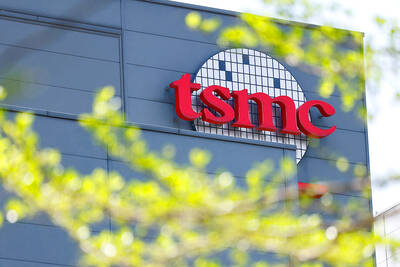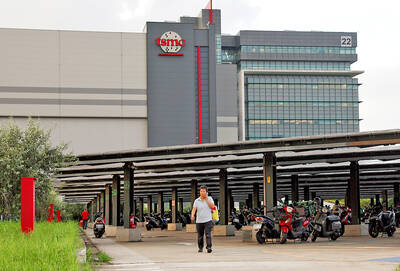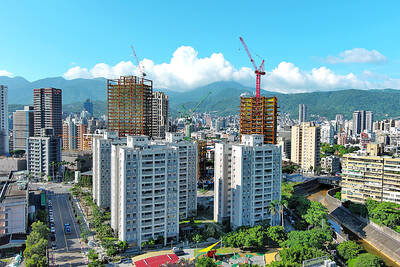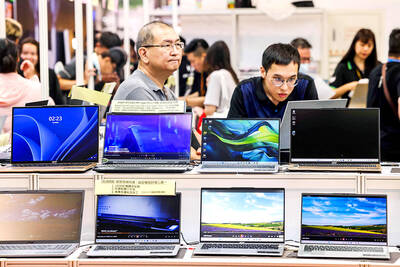The results of the fourth-generation (4G) spectrum auction, which ended on Wednesday after 393 rounds of bidding over 40 days, favor the three major players in the domestic telecommunications industry, analysts said yesterday.
They said the results showed the trio’s construction costs for 4G, or long-term evolution (LTE), services were either in line with or better than their expectations, while the failure of the two new entrants to win the 1,800 megahertz (MHz) bandwidth or the bigger frequency blocks in the 700MHz bandwidth means where will not be any major change in the current market dynamics, they added.
“We see limited downside risk from spectrum costs to our current earnings forecasts on Chunghwa Telecom Co (中華電信), Taiwan Mobile Co (台灣大) and Far EasTone Telecommunications Co (遠傳電信),” Yuanta Securities Co (元大證券) analysts led by Bonnie Chang (張文慧) said in a note to clients.
Hong Kong-based UBS Securities analyst Wang Jinjin (王晶晶) also said the auction results were not a big surprise and therefore would not have a significant impact on major players’ earnings.
However, Credit Suisse analyst Chate Benchavitvila said that higher amortization and financing costs could affect earnings for Chunghwa, Taiwan Mobile and Far EasTone by 4 percent, 8 percent and 12 percent between 2015 and 2016 respectively.
CHALLENGE
“The real challenge for the sector is how these incumbents would improve the monetization of increasing mobile data usage in order to offset higher cost and deliver medium-longer term growth,” Benchavitvila wrote in a note.
“The introduction of tiered-pricing for 4G services would be positive, but the actual impact would depend on details,” Benchavitvila added.
On Wednesday, the National Communications Commission released the 4G spectrum auction results, with Chunghwa securing B2, C2 and C5 frequency blocks at a total cost of NT$39.08 billion (US$1.33 billion); Far EasTone Telecommunications Co (遠傳電信) winning A2, C2 and C4 blocks for NT$31.32 billion; and Taiwan Mobile acquiring A4 and C1 blocks for NT$29.01 billion.
Since the firms secured all the C frequency blocks in the much-desired 1,800MHz bandwidth, they would enjoy a time-to-market advantage over new entrants after they launch their 4G services during the second half of next year, analysts said.
“New entrants received only A or B blocks, which will delay them in competing with the top three by at least 12 months, due to the supply issue in 700MHz and 900MHz-related equipment and smart devices,” Yuanta analysts said.
According to the commission, Hon Hai Group’s (鴻海集團) Ambit Microsystems Corp (國碁電子) won A3 and B3 blocks at a total cost of NT$9.18 billion; Star of Taiwan (台灣之星), a subsidiary backed by Ting Hsin International Group (頂新集團), took B1 block for NT$3.655 billion; and existing code division multiple access technology operator Asia Pacific Telecom Co (亞太電信) secured A1 block for NT$6.415 billion.
BEST POSITIONED
UBS Securities said that of the top three, it believed that Chunghwa is best positioned to launch 4G services, because its C5 block can be deployed right away and it has the widest bandwidth of 15MHz each for upload and download.
Taiwan Mobile could be in a less favorable position for 4G rollout, as its C1 block is currently occupied by Far EasTone and will be available only until June 2017, the brokerage said.
However, analysts said it is too early to conclude who will lead in the 4G race, because the tariffs for 4G services have not been set.
In particular, the two new entrants from Hon Hai Group and Ting Hsin Group are likely to compete with existing players on price, given that there are neither established networks nor brand awareness in the market, they added.
PARTNERSHIPS?
“Should these [new] operators struggle to roll out services, then the impact on the big three should be limited. However, the new entrants are better funded than the WiMAX licensees, and could look to partner with existing operators to bring services to market sooner,” Neale Anderson, a Hong Kong-based analyst at HSBC’s global research division, said in a separate note.
Chunghwa shares rose 0.21 percent yesterday to NT$94.6, while those of Far EasTone were up 4.81 percent at NT$67.5. Taiwan Mobile’s shares climbed 1.52 percent to NT$100.5 and Asia Pacific Telecom advanced 3.17 percent to NT$17.9.

TECH TITAN: Pandemic-era demand for semiconductors turbocharged the nation’s GDP per capita to surpass South Korea’s, but it still remains half that of Singapore Taiwan is set to surpass South Korea this year in terms of wealth for the first time in more than two decades, marking a shift in Asia’s economic ranks made possible by the ascent of Taiwan Semiconductor Manufacturing Co (TSMC, 台積電). According to the latest forecasts released on Thursday by the central bank, Taiwan’s GDP is expected to expand 4.55 percent this year, a further upward revision from the 4.45 percent estimate made by the statistics bureau last month. The growth trajectory puts Taiwan on track to exceed South Korea’s GDP per capita — a key measure of living standards — a

READY TO HELP: Should TSMC require assistance, the government would fully cooperate in helping to speed up the establishment of the Chiayi plant, an official said Taiwan Semiconductor Manufacturing Co (TSMC, 台積電) yesterday said its investment plans in Taiwan are “unchanged” amid speculation that the chipmaker might have suspended construction work on its second chip packaging plant in Chiayi County and plans to move equipment arranged for the plant to the US. The Chinese-language Economic Daily News reported earlier yesterday that TSMC had halted the construction of the chip packaging plant, which was scheduled to be completed next year and begin mass production in 2028. TSMC did not directly address whether construction of the plant had halted, but said its investment plans in Taiwan remain “unchanged.” The chipmaker started

MORTGAGE WORRIES: About 34% of respondents to a survey said they would approach multiple lenders to pay for a home, while 29.2% said they would ask family for help New housing projects in Taiwan’s six special municipalities, as well as Hsinchu city and county, are projected to total NT$710.65 billion (US$23.61 billion) in the upcoming fall sales season, a record 30 percent decrease from a year earlier, as tighter mortgage rules prompt developers to pull back, property listing platform 591.com (591新建案) said yesterday. The number of projects has also fallen to 312, a more than 20 percent decrease year-on-year, underscoring weakening sentiment and momentum amid lingering policy and financing headwinds. New Taipei City and Taoyuan bucked the downturn in project value, while Taipei, Hsinchu city and county, Taichung, Tainan and Kaohsiung

Micro-Star International Co (MSI, 微星科技) is expanding notebook computer production in India after partnering with Indian electronics maker Syrma SGS Technology Ltd late last year, as the Taiwanese company seeks to tap into the local market. MSI also plans to manufacture some of its new gaming PCs powered by Nvidia Corp’s RTX 50 graphics cards in India, while adding more advanced and design-focused PCs and notebooks at Syrma’s plant in Chennai, a source told the Taipei Times yesterday on condition of anonymity. MSI’s deployment in India is driven not only by cost advantages, but also by India’s rapidly expanding consumer market and